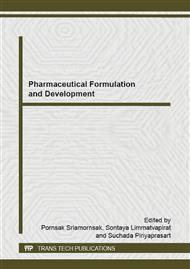p.137
p.141
p.145
p.151
p.155
p.159
p.164
p.168
p.172
Comparison of In Vitro Binding of Various Bile Salts by Coconut Fibers
Abstract:
The aim of this study was to compare the in vitro binding of bile salts by coconut fiber, a by-product of coconut milk extraction. The raw coconut fiber was processed by different methods before binding test, that is, sieving, pulverizing in mortar, grinding by a dry grinder, digesting with 0.1 N hydrochloric acid (HCl), grinding by a dry grinder and then digesting with 0.1 N HCl. The resultant coconut fiber was sieved to obtain the particle size ranged from 250 to 600 μm. Various bile salts, i.e., sodium deoxycholate, sodium cholate and sodium taurocholate, were individually tested and analyzed by high performance liquid chromatography. The results showed that sodium deoxycholate was bound by sieved coconut fiber (9.64%), mortar-ground coconut fiber (12.91%), grinder-ground coconut fiber (28.31%), acid-digested coconut fiber (41.14%), and grinder-ground and acid-digested coconut fiber (37.54%). Similar results were obtained when sodium cholate and sodium taurocholate were tested but to a lesser extent. It can be concluded from these results that coconut fiber may have potential application as a cholesterol-reducing agent.
Info:
Periodical:
Pages:
155-158
Citation:
Online since:
December 2014
Keywords:
Price:
Сopyright:
© 2015 Trans Tech Publications Ltd. All Rights Reserved
Share:
Citation:


